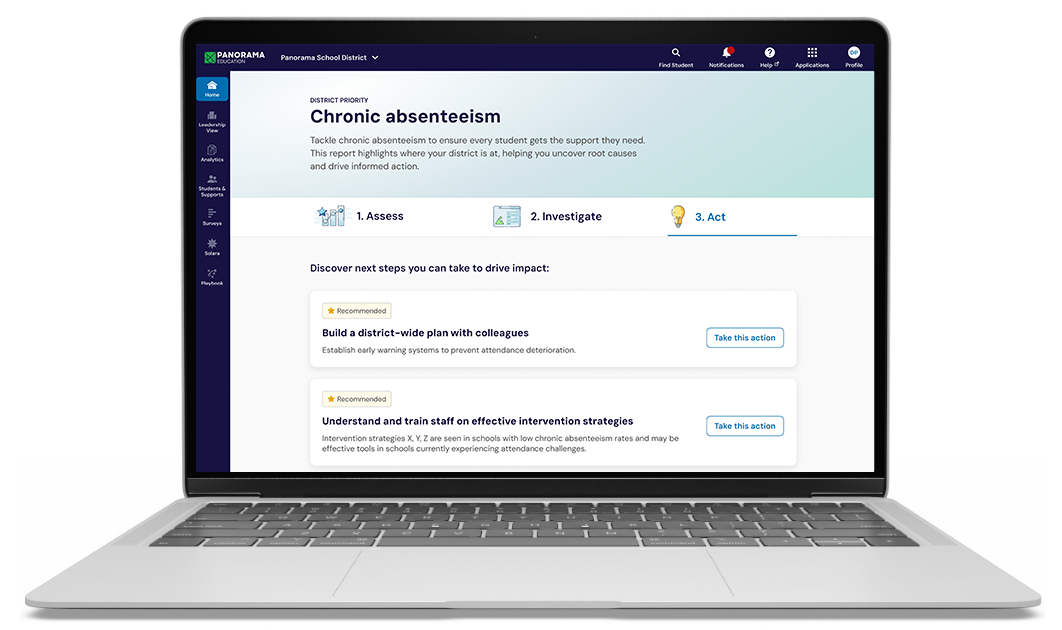Educators are expected to gather and track dozens of data points to understand their students’ needs. But when student information lives across disconnected applications, even a simple report can turn into hours of work piecing together a student’s story. The result? Teams may struggle to spot learning gaps quickly, while school and district leaders are left making decisions without the full picture in view.
Centralizing student data changes that. With a clear, unified dashboard, educators can spend less time chasing information and more time supporting students. District leaders gain visibility into academic trends and early warning signs, while school teams have the insights they need to respond with the right interventions.
Let’s explore why bringing student data together matters—and how using it effectively can open the door for every student to thrive.
What Is Centralized Student Data?
Centralized student data means bringing together information from key sources—such as your SIS, assessments, attendance, and behavior data—into one place. With this view, educators and leaders can easily identify where a student may need extra support and to take action before challenges grow.
District- and school-level dashboards can also highlight important trends across groups of students, helping leaders track progress, spot gaps, and plan next steps with greater confidence.
Why Do K-12 Districts Need Centralized Student Data?
Districts need centralized student data to break down silos and provide timely support. When information is spread across multiple systems that don’t connect, it becomes nearly impossible to coordinate effective multi-tiered systems of support (MTSS). Educators lose valuable time piecing together spreadsheets, collaboration across departments slows down, and critical insights can be missed.
By bringing data together, districts can turn disconnected records into a clear, complete story for each student—making it easier to spot needs early and respond with the right supports.
How Districts Centralize Student Data Systems
Bringing student data into one place is no small task, but it doesn’t have to be overwhelming. Districts that succeed start with a clear, systematic approach—one that reduces disruption for staff while making steady progress toward a unified view of student information. With the right roadmap, the shift to centralized data becomes less about complexity and more about unlocking long-term benefits for students and schools.
1. Conduct a Data Audit
Begin by identifying all the systems currently storing student information. Most districts discover they’re managing more platforms than they realized. Document what data lives in each system and how it flows between departments.
2. Assess Integration Capabilities
Take stock of your SIS, LMS, and assessment platforms. Many modern systems already have built-in integration features you may not be using, while older platforms might need workarounds. Understanding these capabilities early helps set priorities and prevents surprises down the road.
3. Select Integration Methods
Once you know what platforms you’re working with, the next step is deciding how to bring that information together. Many districts lean on direct integrations with their SIS, assessments, and other core systems. In some cases, middleware or a data warehouse may also be part of the picture. What matters most is choosing an approach that aligns with your team’s technical capacity and resources, all while ensuring educators end up with a clear, reliable view of student data.
4. Establish Data Governance Policies
Before connecting systems, clarify roles, permissions, and protocols for data security and FERPA compliance. Decide who owns each data element, how long information should be retained, and how it can be used. Having clear policies in place reduces confusion and ensures consistency.
5. Configure Unified Dashboards
Dashboards should answer the questions educators actually ask—like “Which students need support right now?” or “Which interventions are working?” Start with core metrics such as attendance, grades, and behavior, and expand thoughtfully based on educator feedback. Less is often more.
6. Train Staff on New Workflows
Change is easier when staff see the benefits. Instead of focusing only on technical steps, show real examples of how centralized data helps—like a teacher catching a learning gap early or a counselor connecting attendance patterns to a student’s well-being.
7. Plan a Gradual Rollout
Start with pilot schools that reflect your district’s diversity in size, demographics, and readiness. Use their real-world experiences to refine the process. When peers share their success stories, adoption spreads naturally across the district.
Benefits of Centralizing Student Data
When student data is centralized, teachers, counselors, and administrators gain a clearer, more holistic view of each student. Instead of piecing together fragments from multiple systems, they can spend more time focusing on what matters most: helping students succeed.
With unified data in one platform, districts can shift from reacting after challenges arise to proactively supporting students before issues escalate.
Here’s how access to complete, up-to-date information changes the day-to-day for educators and leaders:
- Complete Student Information for Intervention Teams
MTSS coordinators and student support teams can view grades, attendance, and behavior trends in one place. With this unified perspective, teams can more quickly identify whether a student needs Tier 1, Tier 2, or Tier 3 supports—reducing delays and making interventions more effective. - Faster Trend Analysis for Administrators
With centralized dashboards, school and district administrators can monitor comprehensive performance across schools and grade levels. These insights reveal patterns early, making it easier to allocate resources strategically and respond before challenges grow. - Data-Informed Resource Allocation
Superintendents and school boards gain a clearer picture of where resources are most needed. Integrated data highlights which schools, grade levels, or student groups may require additional academic or behavioral support—guiding decisions about budgets, staffing, and programs with confidence
How Panorama Student Success Centralizes District Data
Fragmented student data makes it difficult for educators, intervention teams, and administrators to respond quickly to student needs. Hours can be lost compiling reports from multiple systems, and important warning signs in academics, behavior, or attendance may go unnoticed. What if districts could bring all of this information together in one clear, easy-to-use platform?
With Panorama Student Success, districts can centralize key student information—such as academic performance, attendance, and behavior—into a single, accessible dashboard. Educators and intervention teams gain a holistic view of each student, helping them plan interventions, monitor progress, and act with confidence.
Because Panorama integrates directly with SIS, assessment, and behavior data sources, staff have access to regularly updated information that reflects the full picture of student experiences. Attendance and behavior dashboards highlight trends, while flexible reporting tools surface the insights that matter most for school and district leaders.
When data is connected, it becomes more than numbers—it becomes a foundation for timely, proactive support.





.jpg)

